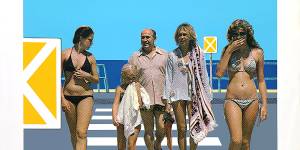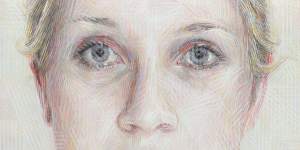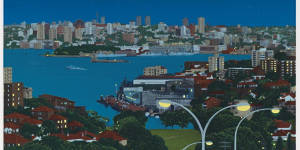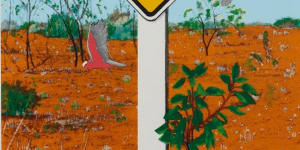In the silk screen prints Robinson made in the 1970s and ’80s,one can still feel the impact of that childhood relocation. Although they depict relatively ordinary aspects of Australian life – birds and animals,the beach,the desert,suburban pastimes – these works are so bright and colourful that they feel unnatural,as if the artist has dialled up the intensity beyond the point at which most of us feel comfortable.

Sally Robinson’s Beach Crossing.Supplied
It’s these dazzling,eye-catching prints that made Robinson’s reputation at a time when the medium was allowed a more prominent role in local contemporary art,largely because of the political poster movement. But while her peers were creating large-edition,militant statements about women’s liberation,Aboriginal land rights,anti-nuclear campaigns and workers’ solidarity,Robinson was cramming her pictures with images of leisure and local wildlife. The political posters still look great,but they have become time capsules,forever welded to the issues of the day. They document the history of movements that have grown up and become part of the political landscape.
By contrast,Robinson’s prints feel as fresh as the day they were made,as visitors to her 50-year survey at the S.H. Ervin Gallery will discover. Looking at two large triptychs,Ayers Rock I,II&III (1978),andMt. Olga I,II&III (1981),one is struck by the vibrancy of the landscape,the brilliant light,and the crowds of birds and animals.

Sally Robinson’s portrait of photojournalist Ella Rubeli.Supplied
I thought of Nicolas Roeg’sWalkabout(1971),made at a time when the Australian film industry was in hibernation. Like Robinson,Roeg had come from England,and been struck by the contrast between the gloom of the northern hemisphere and the ferocious sunlight and heat he encountered Down Under. He didn’t see the desert as a bleak,lifeless place. Every other scene inWalkabout is filled with wildlife,to the point of improbability. It’s only when I learnt from the Australian Wildlife Conservancy that there are more than 4 million feral cats in Australia,which kill four small animals every night,that I thought maybe therewasa lot more animal life in 1970.
Robinson’s prints in these years also owe a debt to the Australian Museum,where she worked as a designer from 1974-83,becoming familiar with the natural history collections. There’s usually a twist in the way she depicts these subjects. InWildlife Sanctuary (1978),a cockatoo seems to be trying to gnaw its way out of a wire enclosure. InSeagulls (1980),the birds are celebrating their exclusive ownership of the beach,flocking around a sign that says there is no inspector on duty.
The human animal is no less closely observed,fromBeach Crossing(1976),which is like a Jeffrey Smart with bikinis,toBondi Bowling (1977),which sets the bowlers in their pristine white outfits against the serene flatness of the green. These images have the quality of snapshots,with subjects not posing for the camera.
One of the more unusual prints isHalley’s Comet (1986),a nocturnal image of Sydney in which the top third of the picture shows the undercarriage of a jet aircraft heading for the skies while the comet descends in the distance. It’s a striking,ambiguous image. As we shoot for the stars,the stars fall down to earth.
A visit to Antarctica in 1991-92 resulted in a stunning series of prints in which Robinson captures this landscape with a clarity and sense of grandeur that has rarely been matched.

Sally Robinson’s Halley’s Comet,1986.Supplied
By the turn of the century,the artist had moved on from printmaking,and was painting distinctive portraits in acrylic. She has since won the Portia Geach Memorial Award on two occasions:in 2012,for a portrait of her mother,who had lost her hair because of cancer treatment;and in 2019,with a self-portrait calledBody in a Box,in which she depicts herself nude,squeezed into a tiny space. Both are included in this survey,along with a portrait of photojournalist,Ella Rubeli,which took out the 2019 Shirley Hannan National Portrait Prize in Bega.
Robinson has completed more than 50 portraits in a little over 20 years,in a highly distinctive style. Although she always aims for a realistic likeness,the surfaces of each work are treated in a more experimental fashion,with colour applied in tiny dabs or dashes,like a variation on the pointillism of Seurat and Signac. Other portraits,such as one of Justice Mary Gaudron (2006),are viewed as if through a translucent screen of words. These varied surfaces prevent Robinson’s portraits from being viewed as simple photo-realism,but they could also be accused of being exercises in design.
The Artist’s Mother(2012) is perhaps the most innovative of the lot,as Robinson has created a pixellated effect that frames her elderly subject’s face,wrinkles and all,while blurring out the edges where the hair is missing. It’s not a flattering image,and Robinson’s mother showed a lot of courage and stoicism in letting her daughter capture her in this manner. Neither does the artist spare herself when she zeroes in on her own ageing features. Indeed,if Robinson has a special virtue as a portraitist,it’s her ruthless fidelity to visual truth. The surface effects are perhaps a way of softening the blow.

Sally Robinson’s Road to Wanaaring (1977).Supplied
The final stanza of this exhibition is devoted to geometric abstract paintings and small sculptures,which are surprising departures from the earlier pictures. On their own terms,these pieces are immaculate creations,but it’s hard to see them as a major advance on the figurative works. It’s a myth that an artist “progresses” from figuration to abstraction. In many cases,it’s merely a choice,a desire to keep one’s vision fresh by trying something new.
This is one way of reading Robinson’s tilt into abstraction,which she handles with her usual aplomb,but for an artist who has built her reputation on strong,recognisable subject matter,it’s difficult to see these new works as much more than sophisticated decorations. This impression is only confirmed by her dip back into subject painting,inBoy Soldiers andAntarctica(both 2015),where a fuzz of words doesn’t detract from the potency of the underlying images – of a military cemetery and a sea filled with icebergs. There’s no doubt Robinson is a more accomplished artist at this late stage of her career,but those vivid works of the 1970s and ’80s have an iconic dimension that once seen,is never forgotten.
Sally Robinson is at theS.H. Ervin Gallery until June 2.
To read more from Spectrum,.